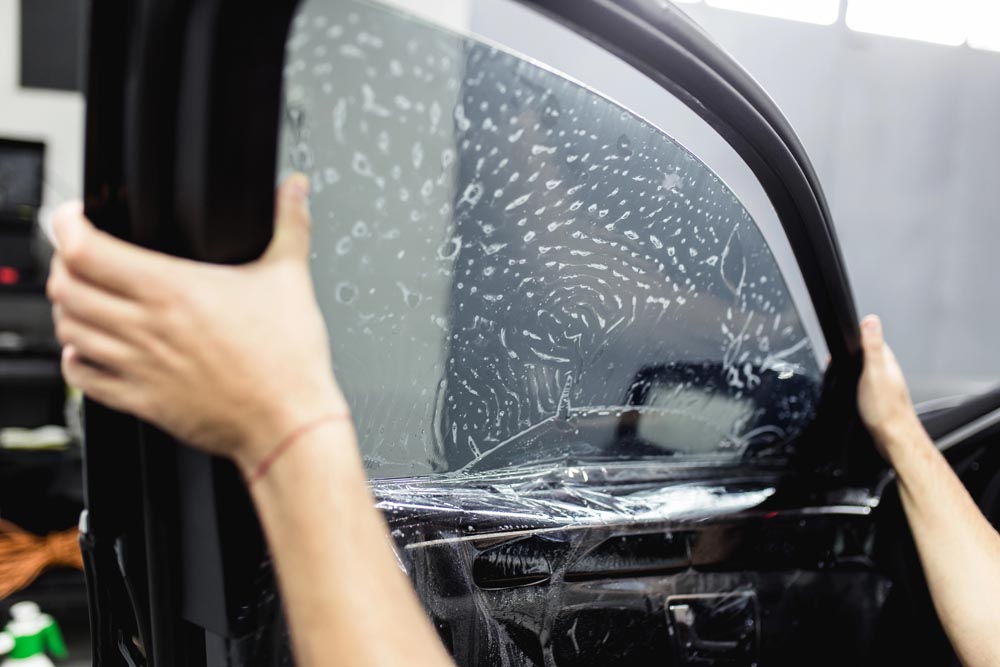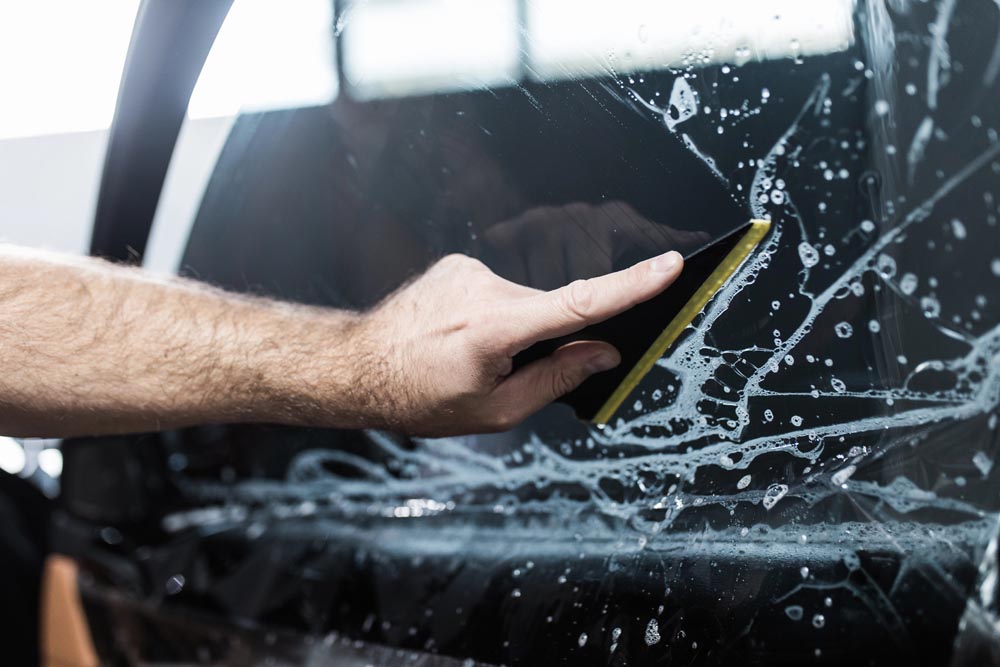General Questions
What is window tinting?
Window tinting is applying a thin film to glass surfaces that reduces heat, blocks UV rays and provides privacy. Professional window film is made up of multiple layers of polyester, dyes, metals or ceramics bonded with adhesives and protective coatings. Modern films offer benefits beyond aesthetics, energy savings, UV protection and security.
How does window tint work?
Window film works by reflecting, absorbing and dissipating solar energy. Different technologies achieve this in different ways: dyed films absorb heat, metalized films reflect it and ceramic films block infrared rays without metal. The film’s layers filter out harmful UV radiation while allowing visible light to pass through, reducing heat gain and glare without darkening your space.
What are the main benefits of window tinting?
Professional window tinting offers multiple benefits: up to 80% heat reduction, lower cooling costs, 99% UV protection, no furniture fading and skin damage, reduced glare, improved comfort and productivity, enhanced privacy and security, shatter resistance in case of breakage and improved curb appeal. Both residential and commercial properties see measurable energy savings and increased property value.
How long does window tint last?
Quality window film professionally installed typically lasts 10-20 years or more depending on the type, climate and exposure. Ceramic and high grade films offer the longest lifespan with minimal fading or deterioration. Residential films generally last longer than automotive films due to less extreme temperature fluctuations. Most professional installations come with manufacturer warranties ranging from 5 to lifetime coverage.

Types of Window Film
What’s the difference between ceramic tint and carbon tint?
Ceramic tint uses nano-ceramic particles to block heat and UV rays without interfering with electronic signals like GPS or radio. It offers superior heat rejection (up to 50% more infrared blocking) and won’t fade over time but costs more. Carbon tint contains carbon particles that provide good UV protection and heat reduction at a lower price point. It has a matte finish that won’t fade but doesn’t reject as much infrared heat as ceramic and may slightly interfere with electronic devices.
What are the different types of window tinting?
Dyed Film: Most affordable option using dye layers to absorb heat and provide privacy. Best for budget conscious projects that require basic sun protection.
Metalized Film: Contains metal particles that reflect heat and strengthen glass. Offers excellent heat rejection but may interfere with electronic signals.Carbon Film: Carbon particles for heat reduction without signal interference. Matte finish and good UV protection at mid-range price.
Ceramic Film: Premium option with nano-ceramic technology for maximum heat rejection, zero signal interference and superior clarity. Most durable and effective but highest cost.
Security Film: Thick, reinforced films that hold glass together if shattered, for protection against break-ins and storms.
Decorative Film: Frosted, patterned or colored films for aesthetics and privacy.
What tint percentage should I choose?
Tint percentage (VLT - Visible Light Transmission) indicates how much light passes through. Lower numbers mean darker tint:
- 70-90% VLT: Subtle tint, maximum light, good for UV protection with minimal appearance change
- 50-70% VLT: Light tint providing heat reduction while maintaining brightness
- 35-50% VLT: Medium tint offering balanced privacy, heat rejection and visibility
- 20-35% VLT: Dark tint for maximum privacy and heat reduction
- 5-20% VLT: Very dark, typically for rear windows or specific commercial applications
Your choice depends on local laws, desired privacy level, heat rejection needs and aesthetic preferences. Commercial buildings often use lighter tints (50-70%) while residential properties vary based on room usage and orientation.

Installation Process
How long does window tint installation take?
Installation time varies by project size and complexity. Residential homes typically take 3-6 hours for standard sized windows. Commercial buildings require 1-3 days depending on square footage and accessibility. Automotive tinting usually takes 2-4 hours. Complex projects with custom cuts, multiple film types or difficult access may take longer. Professional installers work efficiently while ensuring quality results.
Can I install window tint myself?
While DIY kits exist, professional installation is highly recommended. Window tinting requires specialized tools, proper surface preparation, contamination free environment and expert technique to avoid bubbles, creases and uneven edges. Professionals ensure proper film selection for your needs, warranty coverage and long lasting results. Poor DIY installation often leads to peeling, bubbling and premature failure, ultimately costing more to fix.
What’s the installation process?
Professional installation follows these steps:
- Consultation: Assessment of your needs, window measurements and film selection
- Preparation: Thorough cleaning of glass surfaces to remove all dirt, dust and residue3. Cutting: Film cutting to match each window’s dimensions
- Application: Solution applied to glass and film positioned
- Squeegee Work: Water and air bubbles removed with professional tools
- Trimming: Final edge trimming for perfect fit
- Curing: Film to dry and adhere (1-3 days)
- Inspection: Bubble-free, smooth installation check
How do I prepare for installation?
Clear the area around windows, remove furniture, plants and window treatments that may obstruct access. For commercial projects, notify occupants of the installation schedule. Discuss any concerns about specific windows or access issues with your installer beforehand. Most installers handle final cleaning but clearing the space helps speed up the process.

Performance and Regulations
Does window tint really save energy?Yes, it does. Good window film can reduce cooling costs by 30-50% in peak summer months by blocking up to 80% of solar heat. The exact savings depend on film type, window orientation, climate and building characteristics. Most property owners see ROI within 3-7 years through reduced HVAC usage. Plus, tinting reduces temperature fluctuations making spaces more comfortable and allows HVAC systems to run more efficiently.
Will window tint block cell phone or WiFi signals?
Ceramic and carbon films don’t interfere with electronic signals. Metalized films with metal particles can reduce cell phone, GPS, radio and WiFi signal strength. If signal strength is important, choose ceramic film which offers excellent heat rejection with no signal interference. Discuss your connectivity needs with your installer to choose the right film technology.
Are there laws on window tinting?
Yes, vary by location and building type. Residential properties have few restrictions, though HOAs may have guidelines. Commercial buildings must comply with local building codes for light transmission and reflectivity. Automotive tinting has state laws for darkness levels and which windows can be tinted. Always check local laws before installation. Professional tinting companies stay up to date with local laws and ensure compliant installations.
Does window tint provide UV protection?
Yes. Good window films block 99% or more of harmful UV rays (UVA and UVB). This protects furniture, flooring, artwork and fabrics from fading and deterioration. More importantly, it protects occupants from skin damage and reduces skin cancer risk from sun exposure through windows. UV protection is one of window tinting’s most valuable benefits and works regardless of film darkness.
Will tinted windows still let in natural light?
Yes, if chosen properly. Lighter films (50-70% VLT) maintain excellent natural light while blocking heat and UV. Even medium tints (35-50%) provide comfortable brightness for most applications. The key is choosing the right balance for your needs. Modern ceramic films reject heat while maintaining clarity and light transmission, the best of both worlds.
Commercial and Residential
Is window tinting worth it for my home?For most homeowners, yes. Benefits include lower energy bills, furniture protection, increased privacy, reduced glare on screens and living spaces, improved curb appeal and comfort. Homes with large windows, southern or western exposure or high cooling costs see the greatest return. The investment pays for itself through energy savings in a few years and provides immediate comfort improvements.
What are the benefits for commercial properties?
Commercial window tinting offers multiple business benefits: reduced operating costs through energy savings, employee comfort and productivity by eliminating glare and hot spots, professional appearance enhancing brand image, UV protection preserving inventory and interior finishes, security with safety films, meeting sustainability goals and potential LEED points. Many businesses see improved employee satisfaction and reduced complaints about temperature and glare.
Can window tint provide privacy?
Yes, especially reflective, frosted or darker films. During the day, reflective films create a mirror effect preventing outsiders from seeing in while maintaining your outward view. Frosted and decorative films provide constant privacy while allowing light transmission. Darker films (20-35% VLT) offer privacy when interior spaces are darker than outside. For 24/7 privacy, frosted or decorative films work best as reflective films lose effectiveness at night when interior lights are on.
Cost and Value
How much does window tinting cost?
Costs vary widely depending on film type, square footage and project complexity. Residential projects range from $5-15 per square foot installed. Ceramic films cost more than dyed or carbon films but offer better performance. Commercial projects may get volume pricing. Automotive tinting ranges from $200-800 depending on vehicle size and film quality. While upfront costs vary, good films provide long term value through energy savings, durability and warranty.
Does window tint increase property value?
Yes, professional window tinting can increase property value through energy efficiency, curb appeal and upgraded comfort features. Energy efficient improvements are increasingly important to buyers who care about operating costs and sustainability. Commercial properties benefit from reduced operational expenses and happy tenants. While the increase varies by market, window tinting is generally a value add improvement with positive ROI.